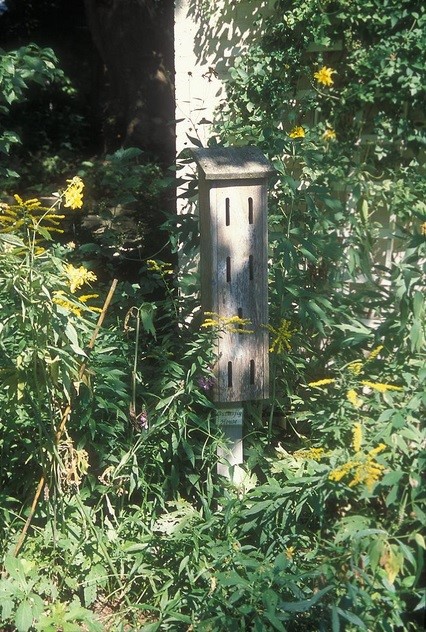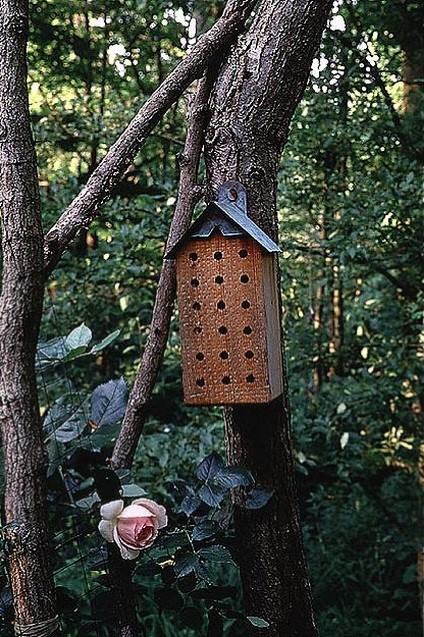Posts tagged ‘butterfly garden’
Pollinator Houses
Gardens are not only places for flowers, trees, and vegetation to grow. Insects such as ladybugs, bees, and butterflies, have an important role in our garden as well. These pollinators propagate flowers and vegetables to keep our gardens flourishing. They are so important to the survival of plants that gardeners have been known to create “homes” for these critters. Bees and wasps use insect houses to keep prey for eggs that have been deposited, while butterflies and ladybugs use them as a place to hibernate.

Grosse Pointe Lighthouse Wildflower Trail Park, Evanston, Illinois, 2007. Mary Ann Grumman, photog. Archives of American Gardens.
The Archives of American Gardens includes terrific images of insect homes. The style and size of insect houses vary just like the houses in which we live. The design of a house depends on the type of bug a gardener may want in his or her garden. For example, the size of the nesting holes drilled into the walls of an insect house influence the type of bug likely to dwell inside. The butterfly houses shown here were constructed in an elongated shape with vertical slits running up and down the sides. Butterflies must fold up their delicate delicate wings in order to fit into these narrow openings. Once inside the insect house provides the butterflies with excellent protection from wind, weather, and predators.

Aspen Farms Community Garden, Philadelphia, Pennsylvania, 1996. Ira Beckoff, photog. Archives of American Gardens.
It is immediately apparent how the holes in this bee house vary greatly from those used by butterflies. Round holes provide bees easy entrance to the house. Unlike bee hives, bee houses are meant to attract solitary bees, such as the Mason Bee (Osmia rufa). This explains why there are multiple holes created in the house rather than one large opening like a bee hive would have.

Giltinan Garden in Charleston, West Virginia, 1997. Jean Allsopp, photog. Archives of American Gardens.
To learn more about pollinators, attend the upcoming Pollination Party at the Smithsonian Gardens Butterfly Habitat Garden on Tuesday, June 16. The Pollinator Party will highlight the Pollinator Partnership’s mission to promote the health of pollinators–which are critical to food and ecosystems–through conservation, education, and research. Click here for more information about Smithsonian Gardens’ Pollinator Party.
– Melinda Allen, Archives of American Gardens intern
June 10, 2015 at 10:18 am smithsoniangardens Leave a comment
The Butterfly Garden: A Haven for Wild Bees
In major urban landscape such as Washington, D.C., a place like the Smithsonian Institution’s Butterfly Habitat Garden serves a valuable purpose as a rich and rewarding refuge, not only for butterflies, but also for bees. With so many flowers in bloom at the end of July, it’s easy to see that bees are very important for pollination. A bee moves from flower to flower searching for nutrient-rich nectar, which it laps up with its hairy tongue. In this process, pollen will collect on the bee’s body and be transferred from one flower to another, providing for the production of the seeds that sustain many gardens and wild-flower populations. On the hind legs of some bees, there are corbiculae, or pollen baskets. These serve a function similar to suitcases, allowing the bees to pack lots of pollen into the baskets for the flight back home to their colony where they share their newfound resource with many others. Solitary bees do not have pollen baskets, but species like leaf-cutter bees have very hairy abdomens, which collect a large amount of pollen. Recently the Butterfly Habitat Garden was abuzz with a large number of bee species, including bumble-, leaf-cutter, honey, and sweat bees, all collecting resources and pollinating flowers.
-Lisa Horth is a Smithsonian Gardens Enid A. Haupt Fellow and an Associate Professor of Biology at Old Dominion University in Norfolk, Virginia, where she studies plant-pollinator interactions.
Protecting Pollinators

Did you know that this week is National Pollinator Week? Every year organizations devoted to conservation celebrate pollinators and address the urgent issue of declining pollinator and plant populations. Pollination is the process of moving pollen within flowers or from flower to flower, allowing the plants to fertilize and reproduce. This movement can be done by wind, water, or a variety of animals, known as pollinators. Animal pollinators assist about 90% of all flowering plants in their pollination needs.

The Pollinator Cycle (pollinator.org)
This year’s focus is on native orchids, which depend on a variety of animals for pollination. What is particularly interesting about the relationships between orchids and their pollinators is that while many insects and animals may visit orchid flowers, each orchid species often has a “preferred” pollinator. Unfortunately, if pollinator populations continue to decline, many species of orchids could be at risk.
This is true too for many of our own food sources, including coffee, bananas, and a variety of tree nuts. These plants are truly dependent on their pollinators and in turn, so are we. According to pollinator.org, “worldwide, approximately 1,000 plants grown for food, beverages, fibers, spices, and medicines need to be pollinated by animals in order to produce the goods on which we depend. In the United States, pollination by honeybees and other insects produces $40 billion worth of products annually.” However, the loss of habitat, chemical misuse, invasive plant and animal species, and various diseases have severely affected pollinator species around the world. Unfortunately, the true scope of damage and the status of pollinators is still unknown, which is why it is so important to work to conserve pollinator species, even the seemingly non-desirable insects, such as flies.
When we think of pollinators, we typically think of the glamorous ones: bees, butterflies, and hummingbirds. However, many plants are pollinated by other animals and insects such as bats, beetles, moths, and even flies; each one has its own distinct attraction to flowers. For example, bees, birds, and butterflies prefer brightly colored flowers, while flies and moths prefer pale or dark colored plants. A diverse selection of native plants in your garden can help to support pollinator populations in your area and maintain botanical biodiversity. Pollinator.org has handy regional guides on what plants are native to your area and attractive to the different pollinators in your eco-system.
So what can we do to protect and encourage pollinator communities? In the Butterfly Habitat Garden, Smithsonian Gardens has committed to planting pollinator-attracting plants free of chemical-based pesticides. In all of our gardens too, an Integrated Pest Management approach is used, meaning that we monitor insect behavior and can then attempt to control insect populations rather than eradicate them. This method can better allow for pollinators to do their jobs, as they are not exterminated by chemical-based pesticides.
Even if you cannot devote a whole habitat to pollinating critters, you can provide a refuge or food source with even one plant. James Gagliardi, horticulturist in the Butterfly Habitat Garden provided a list of some of his favorite plants in the garden that are frequently visited by pollinators:
Hummingbird Mint (Agastache spp)
Boneset (Eupatorium perfoliatum)
Bee Balm (Monarda spp)
Mountain Mint (Pycnanthemum muticum)
Salvia (Salvia spp)
Pincushion Flower (Scabiosa spp)
Goldenrod (Solidago spp)
Verbena (Verbena spp, especially Verbena bonariensis)
Lantana (Lantana camara)
Cardinal Flower (Lobelia cardinalis)
Great Blue Lobelia (Lobelia siphilitica)
–Elizabeth Chenevey, Smithsonian Gardens Education & Outreach Intern
Butterfly Gardens Part 2: Did you know……

Curly Parsley in the Smithsonian Butterfly Garden
As a follow-up to last week’s blog about butterfly host plants, we thought we’d add a few more varieties of host plants that are commonly grown in gardens.
In the Smithsonian Gardens’ Butterfly Habitat Garden, visitors often wonder why we’re growing parsley and tomato plants. We tell our visitors that there are a few plants popularly grown in herb and vegetable gardens which are ideal species for hungry caterpillars (which will transform into butterflies and moths)!

Tomato Plant in the Smithsonian Butterfly Garden
Curly parsley is a popular herb that attracts Anise Swallowtails (Papilio zelicaon) and Eastern Black Swallowtails (Papilio polyxenes) in their larval stage.
Tomatoes attract several species of moths; two of them are infamous to experienced back-yard tomato gardeners. Tomato hornworm (Manduca quinquemaculata) and tobacco hornworm (Manduca sexta) are identified by the “horn” protruding from the rear of the caterpillar. Both are voracious eaters and will munch on tomato foliage and fruit. They are not welcome visitors in most vegetable gardens, but they are invited to dine in the Butterfly Habitat Garden.
If you’re willing to sacrifice some of your herbs and vegetables to sustain a few caterpillars, you will be able to witness the butterfly life cycle just as we do at Smithsonian Gardens!
August 17, 2012 at 2:00 pm smithsoniangardens Leave a comment
Butterfly Gardens Part 1: Host Plants!
What are butterfly host plants? These plants are essentially caterpillar food. Each species of butterfly is pretty specific about the plants they’ll eat at the caterpillar stage. Butterflies will lay their eggs on plants that the newly hatched larvae will eat until they move onto the pupae stage. Hence, if you want to attract certain types of butterflies to your garden, and especially if you’re interested in seeing the egg-caterpillar-pupae-butterfly cycle, it’s important to do a little research.

Butterfly Milkweed in the Smithsonian Butterfly Garden
The monarch lays its eggs on milkweed. An easy way to remember this, is to note the bright orange blooms of the milkweed as the monarch has similar fiery orange coloring. Butterfly milkweed (Asclepias tuberosa) is a shorter version of the common variety. As opposed to growing 3-4 feet tall, it grows only 18-24 inches.

Spice bush in the Smithsonian Butterfly Garden
Planting a spice bush is an easy way to attract spice bush swallowtails. The spice bush is a deciduous shrub which can grow as high as 6-10 feet! Hence, whether you’re looking for a small plant for the front of your herbaceous border (butterfly milkweed) or a larger plant to fill a vacant space in your yard with foliage and butterflies (spice bush), there are lots of options when it comes to choosing your butterfly plants!
By Kristina Borrman, Katzenberger Art History Intern









